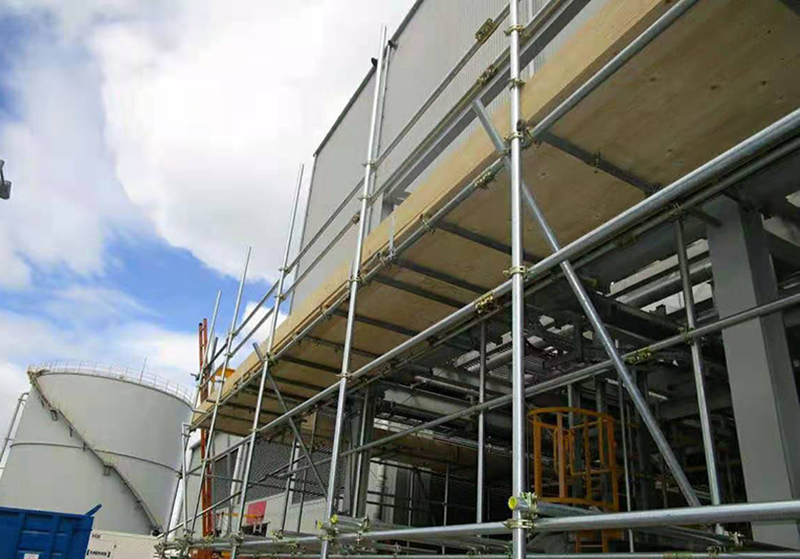When scaffolding is set up, how to match the pipes and couplers?
Although you can choose cuplock, ringlock, cross-lock, etc., for racking, for cost, practicality, and convenience considerations, coupler-type steel pipe scaffolding still occupies most of the market. It can be used not only as outer scaffolding, but also as inner scaffolding, full house scaffolding and formwork support.
Coupler type steel pipe scaffold structure
Coupler scaffolding generally consists of the following parts:
01
Steel Pipe
The steel pipe should be made of Q235A (A3) steel with moderate mechanical properties, and should meet the requirements of medium Q235A steel. The cross section of the steel pipe should be selected according to Table 2-5. The length of the steel pipe is usually: large cross bar, vertical pole is 4 ~ 4.5m, small The horizontal is preferably 2.1~2.3m. The maximum mass of each steel pipe should not exceed 25kg, which is convenient for workers to assemble and disassemble, and can meet the needs of construction.
02
Couplers are used to connect steel pipes. There are three basic forms of Couplers, as shown in the figure below:
Right-angle Couplers, also known as cross Couplers, are used to connect two vertical cross steel pipes;
Rotating Couplers, also known as rotating Couplers, are used to connect two cross steel pipes at any angle;
Butt Couplers, also called in-line Couplers, are used for the butt connection of two steel pipes.
At present, there are two types of Couplers in use in my country: forgeable casting Couplers and steel plate pressed Couplers. Due to the mature manufacturing technology of malleable casting Couplers, national product standards and professional testing units, the quality is easy to guarantee.
Generally, malleable casting Couplers should be made of malleable cast iron with mechanical properties not lower than KTH330-08. The castings should not have cracks, pores, shrinkage porosity, sand holes or other casting defects that affect the use, and the sticky sand that affects the appearance quality should be removed. , Remains of pouring riser, drape seams, wool, oxide skin, etc. are removed.
The fitting surface of the coupler and the steel pipe should be strictly shaped to ensure good contact with the steel pipe when fastened. When the Coupler clamps the steel pipe, the minimum distance between the openings should not be less than 5mm. The movable part of the coupler should be able to rotate flexibly, and the gap between the two rotating surfaces of the rotating coupler should be less than 1mm.
03
Scaffold
The scaffolding board can be made of steel, wood, bamboo and other materials, and the mass of each piece should not be greater than 30kg.
Stamped steel scaffold board is a commonly used scaffold board, which is generally made of 2mm thick steel plate, with a length of 2-4m and a width of 250mm. The surface should have anti-skid measures.
The wooden scaffolding board can be made of fir board or pine with a thickness of not less than 50mm, with a length of 3-4m and a width of 200-250mm. Both ends should be equipped with two galvanized steel wire hoops to prevent the ends of the wooden scaffolding board from being damaged.
04
Wall pieces
The connecting wall piece connects the vertical pole and the main structure together, and can be made up of rigid connecting wall pieces with steel pipes, couplers or pre-embedded pieces, or flexible connecting wall pieces with steel bars as tie bars.
How to match rack tube and coupler
Many newbies are not very clear about this.
Generally speaking, 300 sets of couplers are required for one ton of rack tube.
Among the 300 sets of couplers, the ratio of right-angle couplers, docking couplers, and rotating couplers, is 8:1:1, and the couplers are 240, 30, and 30 respectively.
Coupler inspection and maintenance
In order to ensure the safety and stability of the scaffolding, the couplers must be sent to relevant departments for inspection. The specific regulations are as follows:
1
For buildings below 10 floors, the number of couplers submitted for inspection is 32 sets, including 16 sets of right-angle couplers, 8 sets of rotating couplers, and 8 sets of docking couplers;
2
For buildings below floors 11-19, the number of couplers, submitted for inspection is 52 sets, including 26 sets of right-angle couplers, 13 sets of rotating couplers, and 13 sets of docking couplers;
3
For buildings with more than 20 floors, the number of couplers submitted for inspection is 80 sets, including 40 sets of right-angle couplers, 20 sets of rotating couplers, and 20 sets of docking couplers;
The number of couplers submitted for inspection is different for buildings of different heights. The ratio of the number of couplers submitted for inspection is 2:1:1.
The couplers submitted for inspection need to undergo several tests such as anti-skid performance test, anti-destructive performance test, tensile performance test, compression performance test, etc., and can be put into use after passing the test.
As the couplers are easily corroded by moisture or corrosive substances due to long-term rain, it is best to galvanize or spray paint the couplers.
For old couplers, oil spraying, dipping, brushing, etc. can be used for sealing to prevent the couplers from being oxidized and corroded.
Post time: Mar-16-2021

